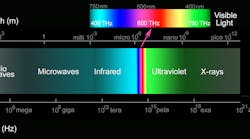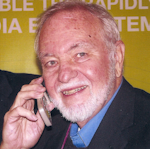What’s the one thing that stifles wireless progress and puts future applications in doubt? Of course, it’s lack of spectrum. And what are we doing about it? To its credit, the industry certainly does what it can, given the tangled set of regulations, policies, red tape, politics, and business practices. But is it enough? If not, wireless progress will continue to be throttled until we find better ways to deal with the spectrum issues.
There’s only so much electromagnetic spectrum. Once it’s allocated and used up, there is no more. Spectrum is a precious national resource. We need to learn how to divide it up and assign it to keep wireless moving ahead. Spectrum is wireless. It should go without saying that lack of access to appropriate spectrum will chill most wireless developments.
Spectrum Issues Won’t Go Away
Currently, most of the sweet spot of spectrum from about 100 MHz to 3 GHz has been allocated and is heavily used. The most common uses are two-way radio, cellular (600 to 2500 MHz), and a few special applications like radar, satellite, and TV. Cellular assignments dominate this part of the spectrum—very little is left to assign to cellular subscriber expansion. And what few segments of these bands become available from time to time are auctioned off. Cellular operators pay billions for these little chunks of electromagnetic space.
Is there a real spectrum shortage? Yes and no. A great deal of spectrum has been licensed to many that want to hold on to it for potential future use or profit. They can’t sell their spectrum holdings directly to others—the FCC won’t allow it. This faulty policy means that lots of good usable spectrum exists, but no one can get to it without the approval of the FCC, which introduces delays and costs. Some of the biggest spectrum hogs are the military and government. They need what they need, but much of it is unused and unavailable.
Spectrum transactions are the duty of the regulatory agencies. In the U.S., these agencies are the Federal Communications Commission (FCC), an independent agency that manages the public and commercial spectrum, and the National Telecommunications and Information Administration (NTIA), a division of the Department of Commerce that manages the government and military spectrum. Spectrum-Related Actions of Note Here are some current activities illustrating that some spectrum is still available, and progress is being made in accessing it:
- The NTIA recently made available a 150-MHz segment of the Citizens Broadband Radio Service (CBRS) band from 3550 to 3700 MHz. This is a shared band. It will continue to accommodate some government radar service, Navy communications, and satellite operators. Cellular operators may apply for this spectrum without having to acquire a spectrum license. More spectrum-sharing schemes are being planned and tested for other spectrum segments.
- A Dynamic Spectrum Sharing (DSS) method is being offered by cellular-network system provider Ericsson in cooperation with 5G chipmaker Qualcomm. It allows those who use Ericsson and Qualcomm products to adapt current 4G LTE spectrum for 5G coverage with a software upgrade. This permits service providers to dynamically switch between their LTE and 5G offerings to facilitate the launch of 5G.
- The C-Band Alliance (CBA) has prime spectrum to sell. The CBA is made up of satellite operators that service the need for TV, radio, and other wireless content distribution. The C band is the designation for the spectrum between 4 and 8 GHz, but some use an extension down to include 3.4 GHz. This band is ideal for 5G. The CBA wanted to auction off 280 MHz of this spectrum for 5G. The FCC said “no, we will do it ourselves to enrich the U.S. Treasury.” Setting up and conducting an auction is very time-consuming (years), but the FCC hopes to expedite this 3.7- to 4.2-GHz spectrum auction later in 2020. Some carriers want to use it for fast, fixed broadband home wireless.
- Initially, most wireless carriers will use their existing or recently acquired spectrum below 6 GHz to implement 5G. These same carriers have also acquired spectrum in the millimeter-wave (mmWave) bands at 24, 28, and 39 GHz. However, it appears that few mmWave 5G systems will be deployed, even next year. The primary rationale for this sub-6-GHz plan is the high cost of implementing the small-cell infrastructure that will be needed to ensure reliable high-speed service over the much shorter distances possible with mmWave frequencies. And add to that a shortage of 5G phones.
- In December 2019, the FCC held an auction for spectrum in the 37-, 39-, and 47-GHz bands. All total, 3400 MHz total spectrum was auctioned. Clearly. the future is in the higher mmWave bands, assuming ICs will be available.
- The FCC’s recent proposal is to reallocate 75 MHz of spectrum in the 5.9-GHz band to a new radio system for vehicles to improve safety. Known as dedicated short-range communications (DSRC), this wireless service implements vehicle-to-vehicle (V2V) and other vehicle communications. In the meantime, a competing technology called C-V2X using LTE and/or 5G services as well as direct vehicle communications has been developed. Most of the auto industry seems to favor it over DSRC. Anyway, the FCC is reassigning the original 75 MHz: 45 MHz of it will go to expand the Wi-Fi unlicensed spectrum to accommodate new Wi-Fi 6 products now coming on line; 20 MHz will go to the C-V2X automotive technology; and the remaining 10 MHz will go to whoever wins the DSRC vs. C-V2X competition. This reassignment really helps Wi-Fi most of all, which is good since Wi-Fi is our main link to the internet and it must be fast to keep up with our 5G connections once they’re in place.
- Another FCC action that may affect spectrum allocations is Chairman Pai’s announced plan to fund support for 5G implementation in rural areas. Many if not most sparsely populated areas or those with difficult terrain have poor or no cell coverage. Especially when it comes to the latest technology like LTE. This $9 billion fund would supplement carrier investments to bring 5G cellular and fast broadband access to the boonies.
- Another spectrum-related issue is the FCC’s recent announcement that 5G radios don’t pose any additional RF radiation problem. The Commissioners voted unanimously to keep the existing rules and regulations regarding the RF threat to humans. Past research indicates that perhaps some harm can come from too much RF exposure. The big question is what’s more dangerous—RF below 6 GHz or that above 6 GHz? For example, do mmWave signals in the 24- to 39-GHz range where 5G activity will take place cause more harm? More definite study is needed, but for now, this isn’t an issue for 5G rollout. For more details, look at Docket No. 19-226 at the FCC site.
Keeping up with all of the existing spectrum issues, assignments, and allocations is an enormous task. And it takes time, money, and in many cases, legal help to acquire new spectrum. And two federal agencies to manage it. Check their websites regularly to keep up with the spectrum news and issues of the day: www.fcc.gov and www.ntia.gov.
By the way, if you want to see the complexity of U.S. spectrum in all its glory, take a look at the NTIA’s color spectrum chart. Order a chart for a wall hanging to constantly remind yourself of what we’re dealing with. NOTE: If you really want to take a deep dive into spectrum issues, I recommend the following book: 5G Spectrum and Standards by Geoff Varrall from Artech House Publishers.

